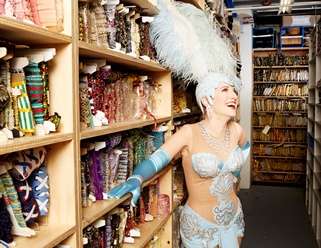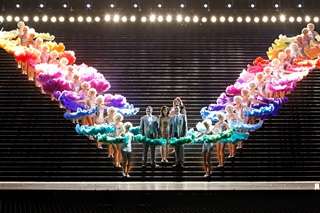|
Back
Opera Australia Ring preview: Part I
11/11/2013

Rhinemaiden L. Gore (© Keith Saunders)
Six years of planning; twenty million dollars; thousands of hours of rehearsals, building and sewing; and it comes down to the final dress rehearsal for this first production in Opera Australia’s Ring Cycle. This is possibly the most anticipated theatrical event in Australia; certainly a landmark for the company and a statement about “coming of age” in the international opera world. The three cycles all but sold out within hours of being announced and thus arose this opportunity to view – but not review – a dress rehearsal (Nov 9, in advance of the Nov 18 opening).
As things stand, this Ring is to be performed only in Melbourne. OA normally presents its operas in both Sydney and Melbourne, but there are no plans for it to go to Sydney, where the theatre and pit are so much smaller. An arrangement for it to be performed by the Houston Grand Opera has fallen through.
In addressing the media, Artistic Director Lyndon Terracini spoke of putting OA “on the map”, making a statement about the quality and dynamism of the company and setting a standard for the future. In the State Theatre of Melbourne’s Arts Centre, replete with newly enlarged orchestra pit to accommodate the 110 players for the cycle, a near capacity audience of media, family and friends assembled for what we were warned may be an interrupted or truncated version of Das Rheingold. What we witnessed was a polished show worthy of any opera season anywhere.
There have been problems of course with this Ring – not surprising given the enormous duration of the project. The original conductor, Richard Mills, withdrew citing “personal chemistry” and was replaced by 33-year-old Finnish maestro Pietari Inkinen, Music Director of the New Zealand Symphony Orchestra. The role of Alberich was originally scheduled to be sung by John Wegner but after his withdrawal due to illness it was assigned to stalwart Opera Australia baritone Warwick Fyfe.
Australian Director Neil Armfield regards the four operas as works “of people’s theatre” and has set out to demystify the plot and to make the productions accessible and as much a parable about the destruction of nature and the environment as a tale of greed, power and corruption. He promised to bring an Australian relevance to the operas – a sentiment much in keeping with Wagner’s own determination to have his works understood widely.
For this production, an orchestra – called the Melbourne Ring Orchestra – has been assembled from around Australia and as far abroad as Norway, Germany and New Zealand. What we heard at the rehearsal bodes well for the upcoming performances.
The design and concepts of the productions have been kept under strict wraps and this has produced speculation and public curiosity. The Director’s vision of an “economy of means...(finding)...the simplest way of telling the story most dramatically” is played out on a vast black stage. The opening Rhine section is dominated by a huge mirror suspended over a sea of swim-suit-clad bodies (100 “ordinary” members of the public) writhing and turning with the movement of water. Between the bodies, the Rhine Maidens rise up; unattainably gorgeous ostrich-feather-caparisoned showgirls flirting and playing with the swimmers, bathed in unmistakeably Australian full summer sunlight. Alberich voyeuristically insinuates himself into the semi-clad scene. He undresses to filthy undergarments and earns the sneers and teasing of the Maidens. This establishes his bitterness and dark turn of mind and marks the interaction he has with other characters leading to Mr Fyfe’s delivery of the curse which sent a palpable chill though the theatre.
Wotan and other gods are corporate types – suits, jewellery, fur coats and dark sunglasses. They use the world and its resources for themselves, seeking at the same time to preserve the museum case stuffed animals of their world at the same time as their actions destroy the environment around them. The giants tear down a vast painted back-cloth which resembles an ancient museum diorama behind the cases of animals, and riding high on mechanical cherry-pickers, looking like characters from The Matrix, they demand payment. This is a striking theatrical moment and the entire theatre was transfixed by the action.
Loge is the ultimate corporate fixer and “spin doctor” sung by heldentenor Richard Berkeley-Steele. He is of the same stuff as the other gods: suited, polished, always on the lookout for the next opportunity.
Perhaps the most dazzling of the theatrical effects was the Rainbow Bridge segment where the rear wall of the black box set draws slowly up to reveal a massive, floodlit staircase stretching to the heavens. The showgirl theme reappears and, carrying huge ostrich-feather fans in every shade of the rainbow, the girls line the stairs in homage to the nightclub extravaganzas that are part of the corporate world we envisage as Valhalla.

(© Jeff Busby)
Audiences are sure to find this production stunning in every sense: the realisation of the plot, the sparse yet striking designs, and the unity achieved in the disciplined, ideas-driven direction by Neil Armfield.
Gregory Pritchard
|